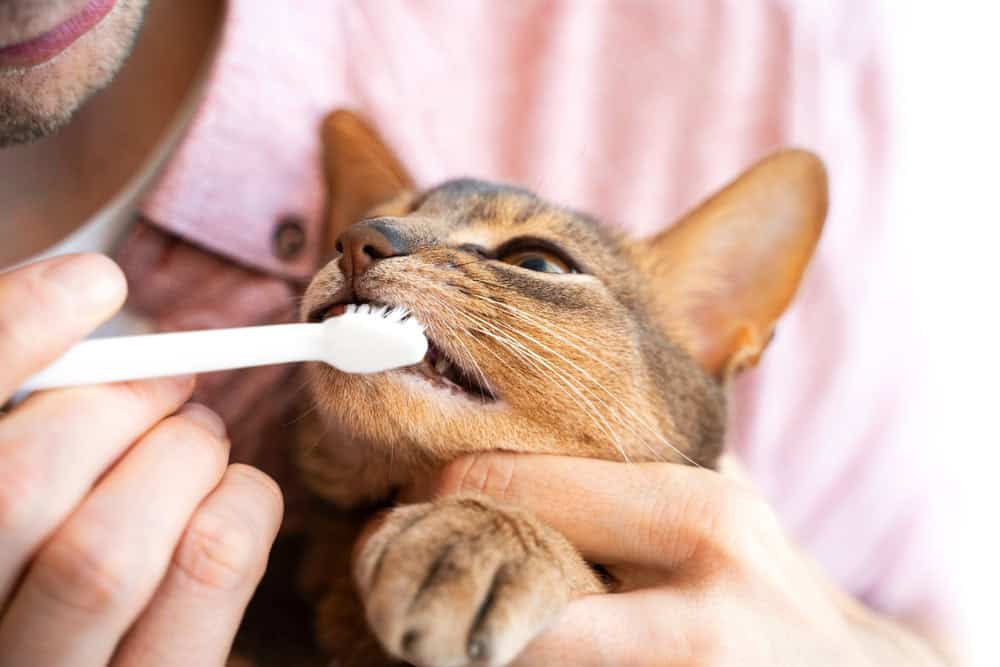Feline resorptive lesions (FRLs), also known as feline odontoclastic resorptive lesions (FORLs), are a common and painful dental condition that affects 40% of adult cats. Understanding this condition is crucial so you can ensure your whiskered friend receives the appropriate care and maintains good oral health. Our Aberdeen Veterinary Clinic team explains feline resorptive lesions, causes, and treatment options.
What are feline resorptive lesions?
FRLs are areas where a cat’s tooth structure breaks down and is reabsorbed by the body. The condition typically starts at the gumline and can progress to the crown and root of the affected tooth, potentially causing the tooth to fracture and causing pain and discomfort for the cat.
What causes feline resorptive lesions?
The exact cause of FRLs is not fully understood, but several factors are believed to contribute to their development, such as:
- Age — Older cats are more prone to developing these lesions.
- Diet — Pet food or diets high in acidic or table scraps, including sugary foods, may contribute to tooth resorption.
- Genetics — Some breeds, including Siamese and Persian cats, are more susceptible to FRLs.
- Oral health — Inadequate dental hygiene and lack of regular dental care can increase the risk for resorptive lesions.
What are the signs of feline resorptive lesions?
Cats are adept at hiding pain, making it challenging for cat owners to detect dental issues. However, signs can include:
- Drooling
- Difficulty eating or chewing
- Preference for soft food
- Weight loss
- Pawing at the mouth
- Red or inflamed gums
- Bad breath
- Behavioral changes
How are feline resorptive lesions diagnosed and treated?
Our Aberdeen Veterinary Clinic team diagnoses FRLs through physical examination and dental X-rays. Because these lesions often start below the gumline, X-rays are crucial for identifying the extent of the damage.
Treatment for FRLs primarily involves managing pain and removing the affected teeth:
- Extraction — The most common and effective treatment for FRLs is extraction of the affected teeth. This procedure is performed under general anesthesia.
- Pain management — Post-operative pain management is crucial. We will prescribe appropriate medications to ensure your feline friend is as comfortable as possible.
- Follow-up care — Regular follow-up visits are important to monitor your cat’s recovery and to check for new lesions.
How do I prevent feline resorptive lesions in my cat?

While it may not be possible to prevent FRLs entirely, there are steps you can take to minimize your furry friend’s risk, including:
- High-quality diet — Feeding your cat a diet that promotes dental health can reduce their risk of oral problems. Consult with our veterinarian about the correct diet for your furry pal. Some studies suggest pet food containing higher amounts of vitamin D contributes to feline resorptive lesions, so ensure you choose a cat food with lower amounts of this vitamin.
- Daily toothbrushing — Brushing your cat’s teeth daily or several times per week can minimize the plaque, tartar, and bacterial buildup that contributes to dental disease. Type 1 feline resorptive lesions can result from inflammation and infection of the oral cavity.
- Wellness exams — Our veterinarian will assess your cat’s teeth and gums during annual or bi-annual wellness exams. Keeping up with your pet’s scheduled exams can help us detect diseases or problems with your whiskered friend when they’re in the early stages.
- Dental cleanings — Professional dental cleanings allow our team to perform a comprehensive evaluation of your cat’s oral health and eliminate plaque and tartar. Cats diagnosed with resorptive disease may need frequent dental cleanings to slow the disease’s progression and manage pain.
Feline resorptive lesions are a serious dental issue that can cause significant discomfort for cats. Early detection and treatment are crucial in managing this condition and ensuring your furry friend’s health and well-being. Regular wellness exams, consistent oral hygiene, and a well-balanced diet can go a long way in preventing and managing FRLs. If you suspect your cat might be suffering from dental issues, schedule an appointment with our Aberdeen Veterinary Clinic team promptly so we can provide the best care for your furry friend.

